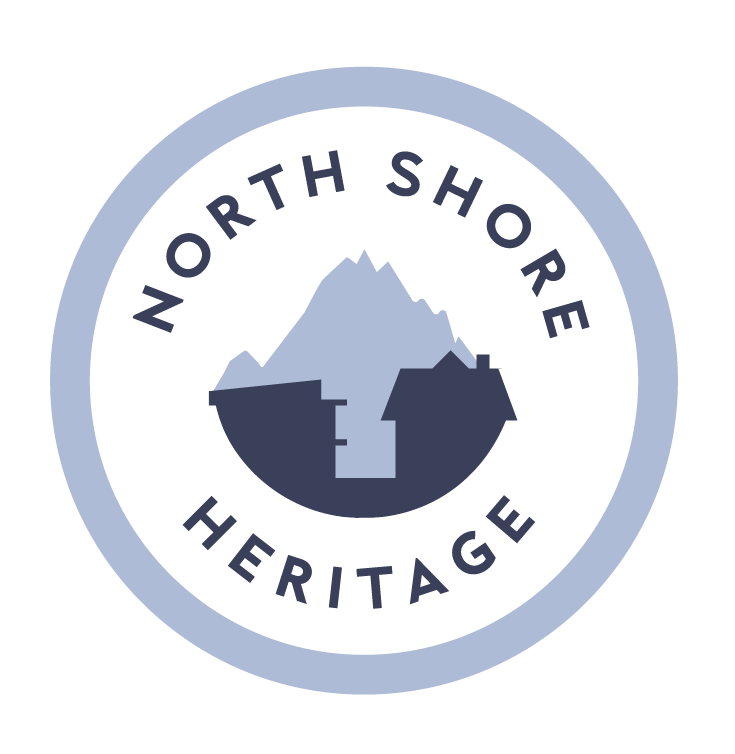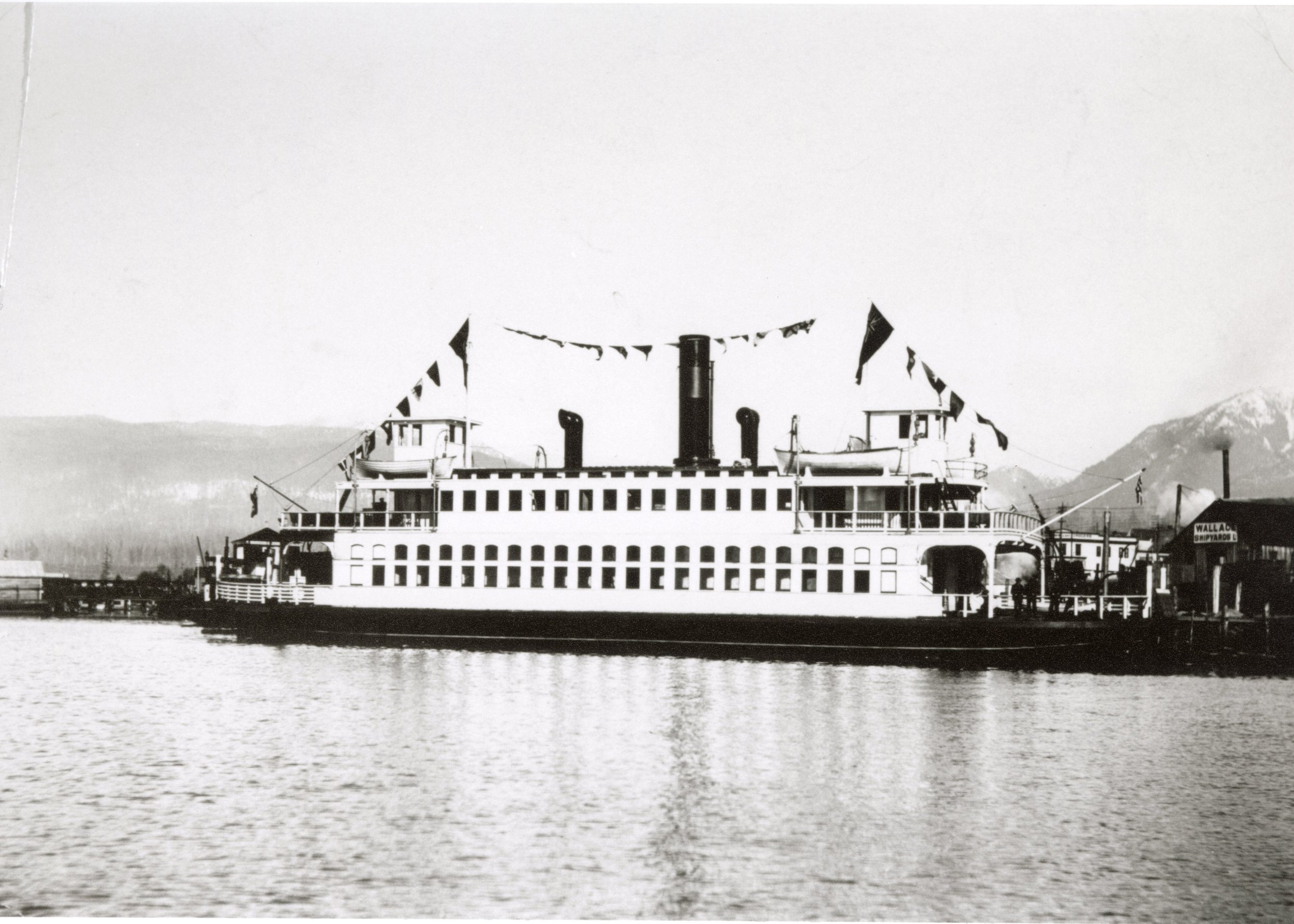My favourite local stroll is to take a walk along the Spirit Trail, past the houseboats, along the Waterfront Park promenade past Goldsworthy Pier and continuing on between the Seabus entry and the bus loop then around, or sometimes through, Lonsdale Quay Market, past the Polygon Gallery’s stark but impressive industrial, informed lines to arrive at the popular and vibrant, community hub at The Shipyards Area and the Burrard Drydock Pier. Except for the pier, none of the above existed before 1977. When you stand at the inlet end of the 1925, 700 foot pier, the spectacular views circle from the Port of Vancouver to the high-rise skyline of downtown Vancouver to Coal Harbour and Stanley Park and Lions Gate Bridge, to Grouse Mountain until looking straight down the pier you are viewing where ships were built, launched and repaired at the Wallace Shipyards & Burrard Dry Dock through two world wars and for decades beyond, bringing secure jobs and prosperity to North Vancouver City.
Burrard Dry Dock Pier today looking north towards Shipbuilding Commons. Photo, Courtesy Colin Lawrence
Wallace Shipyards sign today. Photo, Courtesy Colin Lawrence
It all started in 1906 with the Wallace Shipyards in North Vancouver when Alfred (Andy) Wallace set up shop. For close to a century, The Shipyards Area was a thriving, industrious shipyard where sparks flew from welders’ guns in an environment of bolts and pipes and plates and rivets. Over those years, thousands of men - and at times women - clocked in and out of the yards to build or repair ship after ship, including half of Canada’s Victory Ships during WWII and in 1928, the RCMP Arctic Patrol Vessel called the St. Roch.
Could a young English boy named Andy Wallace, from very modest means in the seaport of Brixham, Devon, ever have imagined that as a young man he would start a new life in Canada with his bride, Eliza, and that together, they would establish a very successful shipyard in North Vancouver and that their eldest son, Clarence, would grow up to become a Lieutenant Governor of B.C., the first B.C.-born appointee? For sure, it would have been well beyond the imagination of the lad or any other lad he knew.
Mr. Alfred and Mrs. Eliza Wallace. In 1906 they founded Wallace Shipyards in North Vancouver. Courtesy of MONOVA/North Vancouver Archives, Inv. 8083.
Alfred and Eliza Wallace with sons Clarence (left) and Hubert. Circa 1912. Courtesy of MONOVA/North Vancouver Archives, Inv. 8087.
Today, the Shipyards Area is a bustling attraction and destination for North Shore residents and also draws neighbours from Metro Vancouver and tourists from around the world with its hotels, restaurants, pubs, coffee shops, summer splash park and winter ice rink. Names like Shipbuilders’ Square, Shipyards Commons, the Pipe Shop, Victory Ship Way, St. Roch Dock and Wallace Mews are a reminder of its shipbuilding past.
But that past is also in the present, since to the east of the Burrard Drydock Pier, there is still an active drydock. The building that is now home to the Tap and Barrel was developed from the original Coppersmith Shop and the nearby Pipe Shop, now used for events and receptions, is the original Shipyard’s Pipe Shop.
Across Shipbuilders’ Square is the Shipyard Commons, a lively gathering hub that is home to the ice rink/splash park and a popular coffee venue as well as Capilano University and was designed to mirror the original machine shop. The area is also the home address for residents in upmarket condominiums.
Burrard Dry Dock – Machine Shop 1968. Courtesy of MONOVA/North Vancouver Archives, Inv. 8462 & 27-90.
Alfred (Andy) Wallace, was born in 1865 into a large family with nine siblings. Just ahead of his teenage years, he was apprenticed to his shipbuilder father spending years learning the trade. When qualified, he expanded his horizons both overseas and working in the Lincolnshire port of Grimsby, at the mouth of the Humber estuary, and it was in this area where he met his future wife, Eliza. Attracted by an opportunity to apply his skills in far-off Canada, with work in the Toronto area, they left England as newlyweds in 1889 for Ontario. The call of the west coast of British Columbia took Andy to Vancouver two years later where he and Eliza were not only life partners but also business partners as Eliza was a canny lass who took care of the books and became President of the company.
Starting their shipbuilding and repair business in False Creek, Andy wasted no hour of the day as he strove to build the business and Eliza wasted no money allowing them to save for expansion of the Wallace Shipyards. Andy started off in Vancouver’s False Creek building wooden fishing boats but relocated in 1906 to deeper water at the foot of Lonsdale. Remember, the first and second narrows bridges did not exist and, foreshadowing the Seabus fleet, a ferry fleet connected North Vancouver to Vancouver. On February 27, 1911, North Vancouver Ferry No. 3 - the first self-propelled boat of any size to be built in North Vancouver - was launched from Wallace Shipyards. On Tuesday July 11th of the same year, a destructive fire tore through the yards. Such a fire might have spelled ruin for some, but not Andy Wallace who had it up and running again in a matter of months.
1911 Launching of “North Vancouver Ferry No. 3” at Wallace Shipyards. Courtesy of MONOVA/North Vancouver Archives, Inv. 12391.
Wallace Shipyards was by then a major North Vancouver employer attracting workers who in turn made North Vancouver their home. This meant significant development of residential houses throughout the area. As the shipyards expanded, so did North Vancouver.
What no one could see in 1911 was a world war that would bring destruction and misery to so many in the world but at the same time brought substantial shipbuilding contracts and further success to Wallace Shipyards. This was also a time of transition from wooden ships to steel. And with more ships having been built, ship repairs became an important aspect of the business and that required a drydock. In 1921, Wallace Shipyards was renamed Burrard Drydock Company but remained in the hands of the Wallace family. In 1925, the first floating drydock in the Vancouver area was installed by the company.
1948 Aerial view Burrard Dry Dock. Courtesy of MONOVA/North Vancouver Archives, Inv. 5703 & 27-1
Looking at view of the Burrard Dock Pier today. Photo, Courtesy Colin Lawrence.
But they were still building wooden ships and the St Roch, launched in 1928, remains the best known today especially as it has its own home at the Maritime Museum in Kits Point where you can see and tour it. A remarkable wooden vessel constructed from Douglas Fir and Australian Eucalyptus to navigate the thick ice of the Arctic Ocean and the North West Passage, it was for many years an RCMP supply ship to remote Arctic communities and was the first vessel to circumnavigate North America. And to think it was built right here in North Vancouver!
A year after the St Roch was launched Andy Wallace died at age 64 leaving behind a legacy of success that had brought prosperity and steady work to North Vancouver. He also left behind two sons who knew how to continue in their parents’ footsteps.
The St. Roch R.C.M.P. Schooner in Burrard Inlet at Burrard Dry Dock 1930. Courtesy of MONOVA/North Vancouver Archives, Inv. 4806
Clarence and Hubert took over, with Clarence as the president. But Clarence was definitely the captain. As a younger man, he had fought in the first great war and was wounded at Ypres. Like his parents, Clarence had a canny business sense and he successfully navigated the business through the Great Depression years of the 1930s. Through his introduction of innovative shipbuilding techniques, Burrard Dry Dock took on the building of many ships during the WWII. Including the merchant cargo Victory Ships, Burrard Dry Dock built 54 at the North Vancouver site and 55 across the inlet at a Vancouver location, totallying 109 ships for the wartime effort. And the success continued in post war years until in 1972 the Wallace family sold the business.
The Fort Alabama Victory type fleet train ship built at Burrard Dry Dock, 1944. Courtesy of MONOVA/North Vancouver Archives, Inv. 7967
Like their parents, the two Wallace boys were achievers. In 1946 Clarence was designated Commander of the British Empire and from 1950 - 1955 he served as Lieutenant-Governor of B.C. and was also productively involved in many aspects of B.C.’s development. The younger by six years, Hubert, was a second in command, who was there to take on the day-to-day management of the Shipyards during Clarence’s Lieutenant-Governor years. In the 1932 Olympics, he was also a member of a sailing team representing Canada!
The Wallace Shipyards - Burrard Drydock story is about one young English boy whose schooling after age 12 was as a shipbuilding apprentice to his father. He came from an ordinary, working-class family. And working class meant, for Andy Wallace, that he was a hard worker, as was his wife, Eliza. They were also achievers who imparted their spirit of hard work to their sons. They set out to develop a shipbuilding company and in doing so contributed significantly to the development and prosperity of the North Shore.
And shipbuilding continues today several blocks west of the Shipyards Area as well. From my back porch I can see the enormous blue gantry, one of North America’s largest gantry cranes, and beyond that I can also see the newly constructed hull of a huge vessel being built that grows larger by the day. It all started with Andy and Eliza Wallace and their Wallace Shipyards.
Reading suggestions and resources:
I discovered in researching Wallace Shipyards & Burrard Dry Dock that there is an abundance of information on the subject that is more than a short blog piece can accommodate. Two brief examples are:
the pier in Waterfront Park is called the Goldsworthy Pier named after CNV Mayor Goldsworthy (1948-1953) who was the electrical superintendent at Burrard Drydock before and during the war years.
Scottish born, British Arts and Crafts and Tudor Revival architect, Henry Blackadder is celebrated in North Vancouver for his work with fellow Scottish architect, Alexander Sinclair Wemyss Mackay, in the construction of the J.P. Fell Armoury and the Victoria Park Cenotaph, and the design of many of North Vancouver’s distinctive heritage houses including the 1912 Thomas Nye residence. Henry and Alexander served Canada overseas during WW1. During WW11, Henry Blackadder worked in the drawing office of Burrard Dry Dock from 1941 until the war ended.
MONOVA, North Vancouver Museum and Archives are an excellent source of information about Wallace Shipyards and Burrard Dry Dock, and of course so much more about North Vancouver
Two in-depth books available at CNV Library are:
LAUNCHING HISTORY: The Saga of Burrard Dry Dock, by Francis Mansbridge.
The Ambitious City: A History of the City of North Vancouver, by Warren Sommer.











